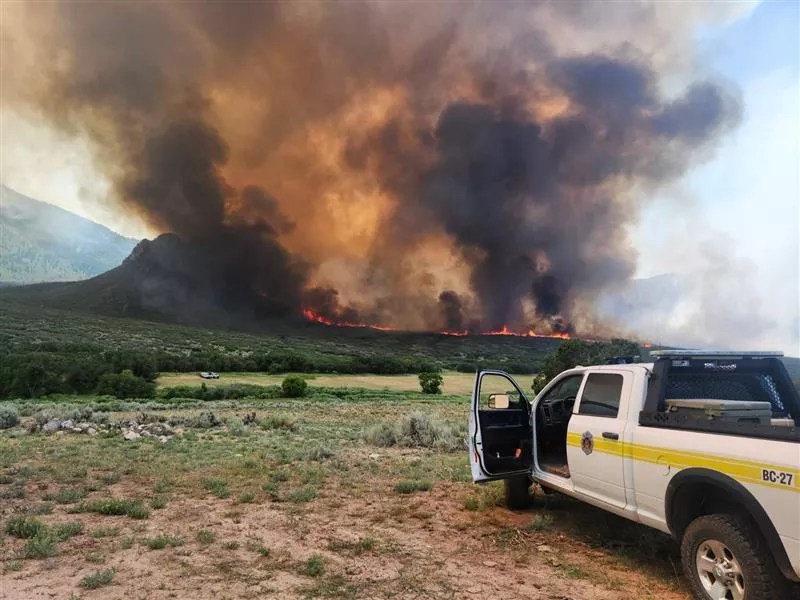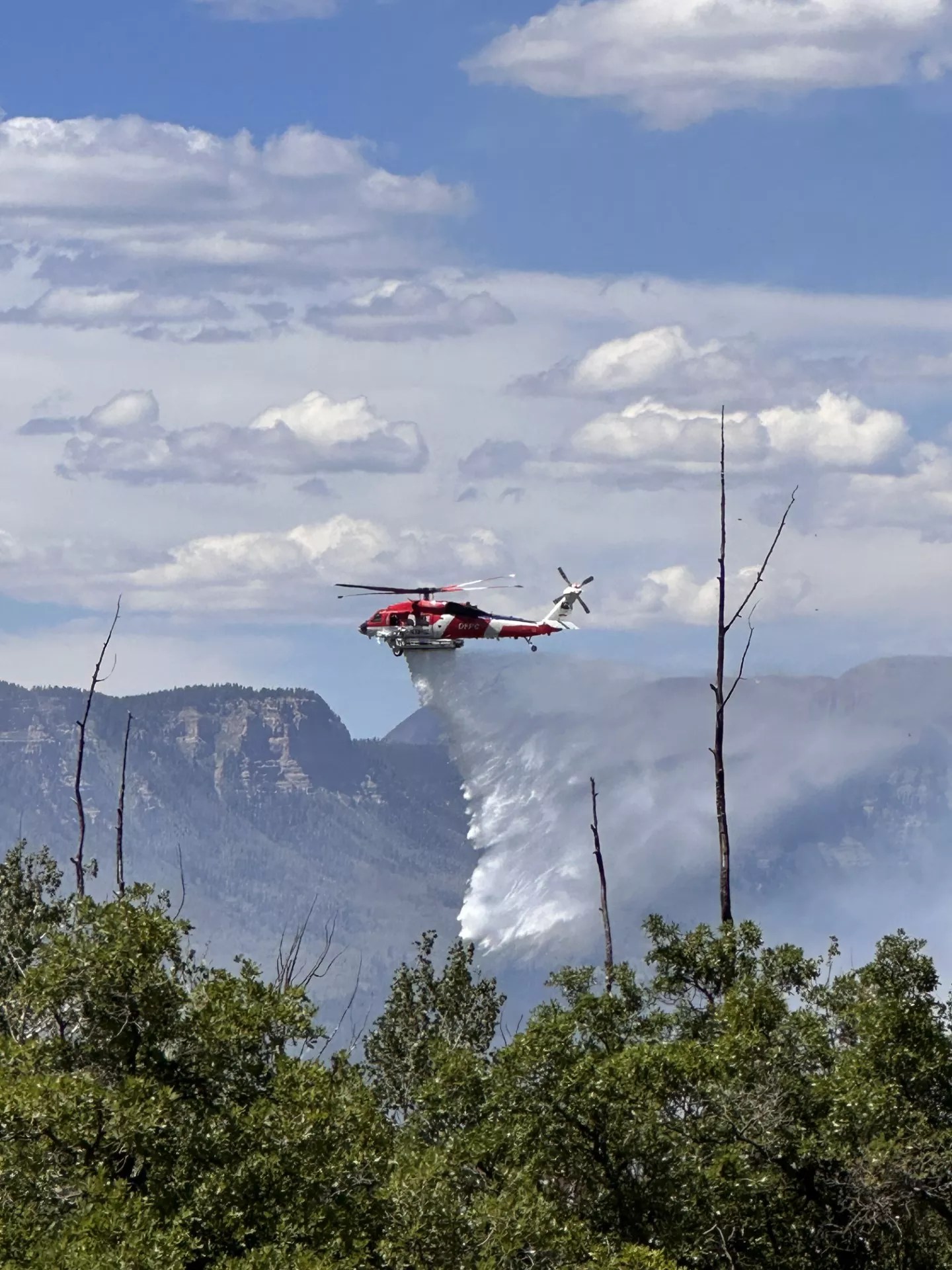
inciweb.wildfire.gov

Audio By Carbonatix
Summer wildfires are tearing across Colorado, particularly along the Western Slope, where drought and low rainfall are making containment difficult.
Nationally, the number of wildfires in 2025 is higher than in 2024; the National Interagency Fire Center reports that there have already been nearly twice the number of fires this year than last year, with 40,654 blazes reported thus far. Those fires have consumed over 3.2 million acres; fires burned a total of 4.5 million acres last year.
According to the National Interagency Fire Center, three large fires are currently blazing in Colorado. The South Rim fire at the Black Canyon of the Gunnison National Park in Montrose County that started on July 10 after a lightning strike is still only 52 percent contained, having consumed over 4,000 acres.
The Turner Gulch fire, near Gateway in Mesa County, was also discovered on July 10 after lightning storms. That fire has already covered over 21,000 acres and is 51 percent contained.
This year, make your gift count –
Invest in local news that matters.
Our work is funded by readers like you who make voluntary gifts because they value our work and want to see it continue. Make a contribution today to help us reach our $50,000 goal!
The Elkhorn fire, in La Plata County near Durango, started burning on July 26; its cause is still unknown. It’s burned 317 acres and is just 5 percent contained.
“We’ve got some of the biggest fires that we’ve had in a few years, but it’s nowhere near what we saw in 2020 or 2018, at least up to this point,” says Russ Schumacher, director of the Colorado Climate Center and Colorado State Climatologist.
“The conditions that make things favorable for wildfires to grow quickly are if it’s hot, dry and windy,” he notes. “In that period a couple weeks ago when those fires were growing really rapidly, it was sunny and not much moisture was in the air, no rainfall.”
Thunderstorms without much rainfall can start fires, which is what happened with the South Rim and Turner Gulch fires, he adds.
The clouds, humidity and afternoon rain that come along with monsoon season can all help fire crews curb the progress of wildfires, Schumacher says, so battling fires has gotten slightly easier over the last week.
According to the National Weather Service, the last few years have all seen slow starts to monsoon season in July.
“Both this year and last year have seen well below average precipitation across most of the state, and 2023 was dry across most of the state – though northern I-25 corridor and southeast Colorado did see better precipitation,” says Zach Hiris, an NWS meteorologist.
Most of metro Denver is at near-normal rainfall levels, with 11.11 inches of rain this year compared to the normal expectation of 11.02 by this tme. Last year’s rainfall total was similar to this point, but 2024 registered high precipitation from February to April followed by a dry summer, while this year was dry during spring and wetter in May and June, Hiris says.
This year, the state is seeing an east-west split on rainfall and drought. The Interstate 25 corridor and plains to the east are drought-free or in abnormally dry conditions, which is the lowest measure on the drought monitor. West of the Continental Divide, there is widespread extreme drought.

Firehawks are being used to fight the Elkhorn fire.
inciweb.wildfire.gov
“This is a stark difference compared to last year, where drought conditions were observed mainly across the Front Range while the rest of the state was either drought-free or in abnormally dry conditions,” Hiris says.
If a part of the state had a wet season last year and a dry one this year that area may be more prone to long-lasting wildfires, Schumacher says, as an excess of fuel has likely now gone dry. That dynamic could be contributing to blazes on the Western Slope.
But Colorado doesn’t wait to see what conditions will be like before strategizing to fight the year’s fires.
In February, the Colorado Department of Natural Resources teamed up with Governor Jared Polis to invest $8.4 million in fire-related projects throughout the state through the Colorado Strategic Wildfire Action Program. COSWAP works to restore forests and protect communities, watersheds and infrastructure from wildfires; the February investment treated 1,045 acres of land and trained over 150 wildfire mitigation workers.
“I am pleased we are able to provide significant new funding for on-the-ground hand crews and training and significant landscape-scale projects to a wider range of Colorado communities for forest mitigation and watershed protection work,” Dan Gibbs, executive director of the Colorado Department of Natural Resources, said at the time. “Our COSWAP program rose up out of the devastating 2020 wildfire season, and I am proud of the growth and innovation the program has shown.”
Some of the investments went toward water infrastructure improvements to help mitigate hazards that can be result from fires, like floods. Boulder, Collins, Glenwood Springs, the Grand Fire Protection District and the Mancos Conservation District received money to treat a combined 1,313 acres of watershed over the next three years.
“The City of Glenwood Springs and Grand Fire Protection District projects are both located in high wildfire risk areas as well as high priority watersheds that drain into the Colorado River,” DNR reported. “Ultimately, supporting projects that integrate forest and watershed health will promote long-term ecological resilience.”
And the state didn’t stop there. In March, Polis and the Colorado State Forest Service announced $7.04 million in wildfire mitigation grants to fund 37 projects helping to reduce wildfire risk and forest health. The funds were available through the Forest Restoration and Wildfire Risk Mitigation grant program.
“Colorado is one lightning strike and one unattended campfire away from our next wildfire,” Gibbs said of the FRWRM funding. “With about half of all Coloradans living in the wildland urban interface, these grants provide important capacity for locally and regionally driven wildfire prevention efforts.”
More FRWRM grants will become available in the fall, when fire season could pick up again.
“Here in Colorado and throughout the West, I think most people have come to recognize that there is no fire season per se,” Schumacher says. “Most of the really big fires tend to happen in the summer, but we’ve seen situations like the Marshall Fire in the middle of winter. … People need to be aware of when there’s drought conditions, when there’s dry vegetation, to be really careful with fire in those situations.”